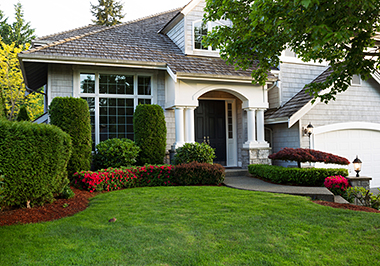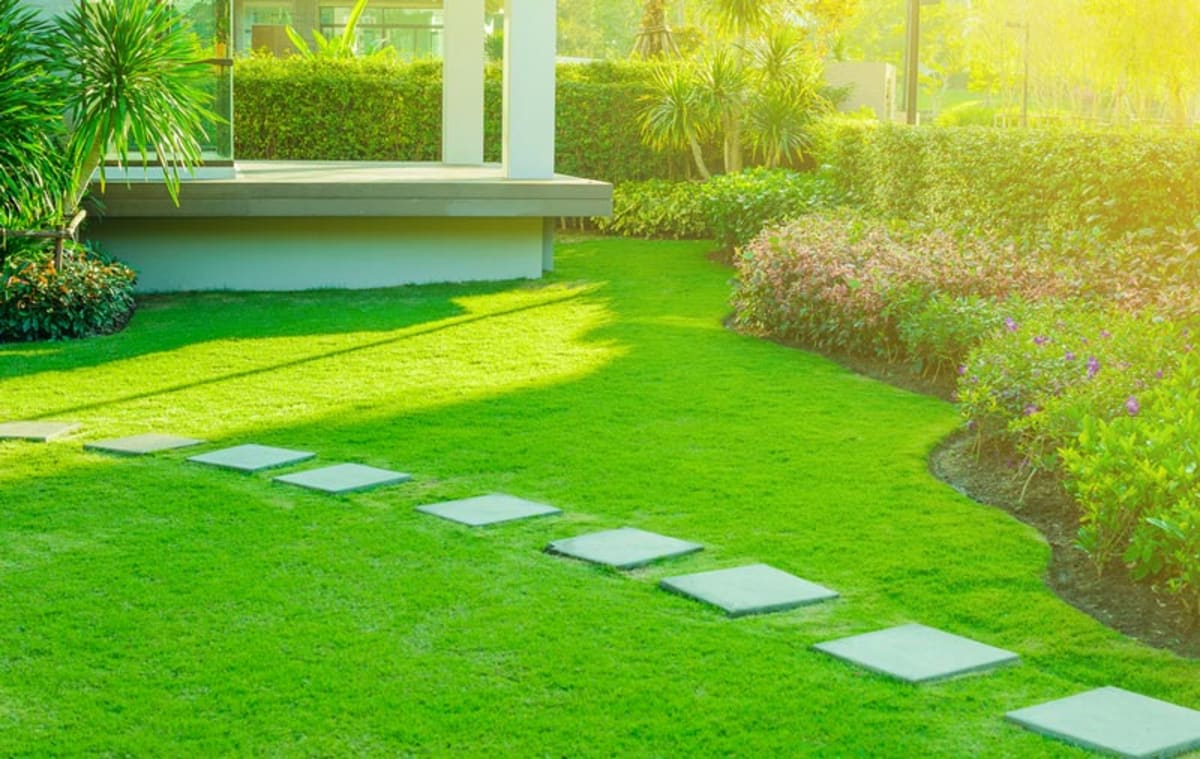Recognizing the Comprehensive Range of Works in Professional Landscape Design Services
The extensive range of expert landscape design services includes a range of basic components - landscaping services. It includes landscape layout concepts, plant choice, and hardscaping attributes. Furthermore, it addresses watering systems and upkeep methods. Each facet plays an important duty in developing practical and cosmetically pleasing outdoor rooms. Recognizing how these components work together can reveal much regarding the art and science of landscape design. The journey right into this elaborate field is simply starting.
Landscape Design Principles
Reliable landscape style concepts are crucial for developing unified outdoor areas that enhance both aesthetic appeal and performance (Learn More). These principles lead the plan of aspects within the landscape, making sure a cohesive aesthetic experience. Secret parts consist of balance, which distributes aesthetic weight evenly; percentage, which connects the size of numerous elements to every other and the space; and unity, which creates a sense of wholeness with regular themes and materials

Plant Choice and Setup
In the domain of specialist landscape design, plant choice and setup play an important role in attaining a thriving garden. Stressing indigenous plant advantages, seasonal factors to consider, and the certain soil and sunshine demands of each types guarantees a lasting and cosmetically pleasing landscape. Careful planning in these locations not only improves biodiversity but additionally promotes lasting ecological health.
Indigenous Plant Benefits
Why should property owners think about indigenous plants for their landscaping tasks? Native plants supply various advantages that enhance both aesthetics and environmental sustainability. They are well-adapted to local environments, needing less water and maintenance compared to non-native types. This strength reduces the requirement for chemical fertilizers and chemicals, promoting a much healthier ecological community. Furthermore, native plants offer habitat and food for regional wildlife, consisting of pollinators, which can raise biodiversity in houses. Their knowledge with regional soil and climate condition likewise results in far better growth rates and long life. By choosing native plants, home owners not only produce aesthetically enticing landscapes however additionally contribute to ecological conservation, making a favorable effect on their neighborhood atmosphere. Indigenous plants represent a smart option for landscaping jobs.
Seasonal Plant Considerations
Homeowners that have accepted native plants in their landscape design can better boost their outdoor rooms by considering seasonal plant choices. By incorporating plants that grow in specific periods, they can develop dynamic and aesthetically appealing landscapes throughout the year. Springtime may introduce vibrant flowers like daffodils and tulips, while summer season can showcase rich foliage and vivid perennials. Autumn introduces a scheme of warm tones with goldenrods and asters, while winter can be accentuated with evergreens and ornamental turfs for appearance. Professional landscapers frequently suggest picking plants that not only enhance existing indigenous species yet additionally give year-round passion and support neighborhood wildlife. This thoughtful technique to seasonal plant choice ensures a constantly developing and sustainable garden environment.
Soil and Sunshine Requirements
Successful landscaping rests on recognizing the certain soil and sunshine demands of plants. Various varieties grow under varying conditions, needing a cautious evaluation of both factors throughout the selection process. Dirt kinds, such as sandy, clay, or loamy, impact drain, nutrition accessibility, and origin development. In addition, pH levels can impact plant health and wellness, requiring soil screening to identify suitability. Sunshine needs differ substantially; some plants thrive completely sunlight, while others favor complete or partial shade. An expert landscaping company thinks about these aspects to ensure peak growth and visual charm. By lining up plant options with the atmosphere's specific characteristics, landscapes can achieve sustainability, durability, and visual consistency, inevitably leading to effective plant facility and long-lasting upkeep.
Hardscaping Attributes and Construction

While landscaping commonly stimulates pictures of lush plant and vibrant flowers, hardscaping attributes play an important function in defining exterior rooms. These aspects, which include outdoor patios, sidewalks, preserving wall surfaces, and attractive stonework, offer structure and performance to yards and lawns. Hardscaping utilizes materials such as concrete, wood, rock, and brick, enabling for diverse layouts that enhance the natural landscape.
The building and construction of hardscaping attributes calls for careful planning and implementation to guarantee longevity and aesthetic appeal. Experts assess website conditions, drain, and spatial relationships to produce cohesive exterior settings. Correct installation techniques are critical, as they protect against issues like disintegration and moving in time.
Integrating hardscaping not just enhances the visual interest of a residential property however likewise facilitates outdoor tasks, making it an essential facet of thorough landscape design services. Ultimately, thoughtful hardscaping adds to both the functionality and appeal of exterior areas.
Irrigation Equipments and Water Monitoring
Efficient irrigation systems and water monitoring are essential components of expert landscaping, as they guarantee that plants get the essential hydration for excellent development. These systems can vary from straightforward drip irrigation configurations to innovative automated sprinkler systems, created to satisfy the specific requirements of varied landscapes. Proper water monitoring not only maximizes water use, reducing waste, yet likewise boosts plant health and reduces condition risks.
Landscape design specialists examine different factors, including dirt type, plant species, and regional climate, to develop tailored irrigation options. Additionally, including rainwater harvesting techniques can even more improve sustainability and performance. Normal upkeep of irrigation systems is vital to maintain functionality and prevent leaks, which can result in water loss and boosted costs (Learn More). Inevitably, a well-designed irrigation system plays a critical duty in preserving the aesthetic charm of exterior rooms while advertising ecological stewardship within specialist landscaping methods
Lawn Care and Upkeep Approaches
Lawn treatment and upkeep methods are basic for accomplishing a rich, healthy lawn that boosts the overall landscape. These approaches incorporate various methods aimed at advertising excellent development and visual charm. Routine mowing is important, as it encourages thick, even growth while protecting against weeds from developing. Additionally, appropriate fertilization provides necessary nutrients, with applications tailored to the certain turf type and soil conditions.
Watering methods should concentrate on deep, infrequent irrigation to urge root advancement, while aeration boosts soil structure and advertises vitamins and mineral absorption. Bug and condition monitoring is also critical; recognizing concerns early allows for effective therapies that decrease damage.
Lastly, overseeding can revitalize damaged or thin grass, improving density and color. By implementing these targeted grass treatment strategies, landscape design experts can guarantee that yards stay healthy and lively throughout the periods, greatly adding to the general charm of the residential property
Seasonal Landscape Care and Upkeep
As the seasons adjustment, correct landscape care comes to be crucial for keeping the health and wellness and appeal of outdoor areas. Each period presents unique difficulties and needs. In spring, landscape professionals concentrate on trimming, growing, and fertilizing to encourage development. Summer season needs regular watering, weed control, and parasite monitoring to safeguard freshly developed plants.

Throughout the year, seasonal landscape upkeep assurances that exterior locations stay healthy and balanced and aesthetically attractive. Expert services can provide tailored upkeep plans that adapt to the certain requirements of each season, enabling homeowner to enjoy lively landscapes year-round. On the whole, seasonal care is an essential aspect of professional landscape design that advertises durability and aesthetic value.

Lasting Landscape Design Practices
An expanding number of homeowner are embracing sustainable landscaping techniques to create eco-friendly outside areas. These practices concentrate on preserving sources, improving biodiversity, and minimizing ecological influence. Indigenous plants are usually selected for their low tide requirements and compatibility with neighborhood environments, minimizing the demand for chemical fertilizers and chemicals. Rain yards and absorptive paving are utilized to take care of stormwater drainage, advertising groundwater recharge and decreasing erosion.
Moreover, sustainable landscape design includes organic horticulture techniques that focus on dirt health and wellness and advertise all-natural insect control. Reliable irrigation systems, such as drip irrigation and rain harvesting, help maximize water use. Furthermore, landscape designers progressively promote for making use of recycled products, such as recovered wood and rocks, to reduce waste. By embracing these lasting techniques, homeowner not just add to eco-friendly preservation but likewise create visually pleasing environments that can love very little upkeep.
Regularly Asked Concerns
For how long Does a Landscape Design Job Commonly Require To Full?
Usually, a landscaping task can take anywhere from a few days to several weeks to complete, depending upon the project's style, complexity, and size needs. Aspects such as climate and source accessibility also affect timelines.
What Factors Impact the Price of Landscaping Services?
Different elements influence landscaping service costs, consisting of job dimension, design complexity, material top quality, labor expenses, geographical place, and seasonal demand. Each element contributes distinctively to the overall monetary demands of a landscape design job.
Are Landscaping Solutions Available Year-Round?
Landscaping services are generally offered year-round, although accessibility might vary based on area, seasonal climate problems, and certain service offerings. Some services could be restricted throughout extreme climate or off-peak seasons.
Do Landscape Design Firms Deal Guarantees on Their Job?
Many landscaping companies do offer warranties on their work, which can vary in size and protection. Clients are encouraged to ask concerning details terms, guaranteeing they recognize what is assured and any kind of problems that use.
Can I Style My Landscape Without Expert Help?
Yes, individuals can develop their landscapes without review professional help. They may do not have competence in plant option, design, and environmental factors to consider, potentially leading to much less reliable layouts that might need expensive adjustments later on.
In the domain name of professional landscaping, plant choice and installation play a crucial function in attaining a flourishing garden. Home owners that have actually welcomed indigenous plants in their landscape design can additionally improve their outdoor areas by considering seasonal plant selections. Effective landscaping pivots on understanding the specific dirt and sunshine needs of plants. Effective irrigation systems and water monitoring are vital elements of professional landscaping, as they guarantee that plants obtain the essential hydration for excellent growth. Landscape design professionals assess various elements, including soil kind, plant types, and neighborhood environment, to create customized irrigation options.